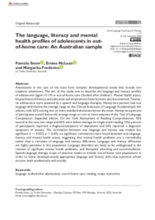Abstract
Adolescents in the care of the state have complex developmental needs that include low academic attainment. The aim of this study was to describe the language and literacy profiles of adolescents (aged 13–19) in out-of-home care (‘looked after children’). Mental health status, biopsychosocial history, and education and employment histories were also documented. Twentysix adolescents were assessed by a speech and language therapist. Ninety-two percent had oral language skills below the average range on the Clinical Evaluation of Language Fundamentals: 4th edition, with 62% scoring two or more standard deviations below the mean. Ninety-two percent of participants scored below the average range on two or more subtests of the Test of Language Competence: Expanded edition. On the York Assessment of Reading Comprehension, 92% scored in the very low range and 65% were below-average on single-word reading. Fifty percent of participants reported a diagnosis/symptoms of depression and 54% reported a diagnosis/ symptoms of anxiety. The correlation between oral language and literacy was modest but significant (r = 0.502; p ⩽ 0.05); no significant correlations were found between oral language, literacy and mental health status, suggesting that mental health problems are a comorbidity rather than a correlate of language and literacy difficulties. Language and literacy difficulties are highly prevalent in this population. Language disorders are likely to be undiagnosed in the context of significant mental health problems, and disrupted schooling and accommodation. Speech-language therapy scope of practice needs to include out-of-home care populations in order to foster developmentally appropriate language and literacy skills that maximize school success, both academically and socially

